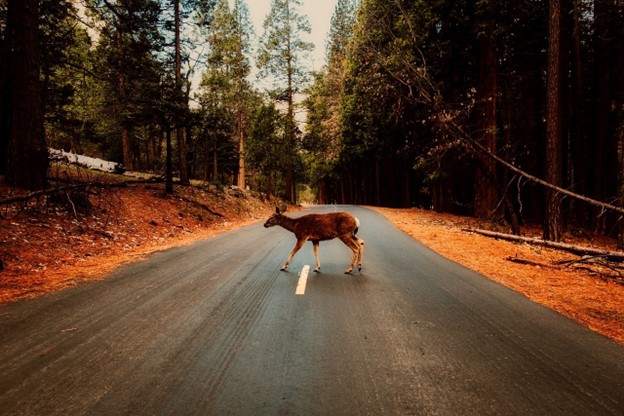
Over the past several years, there has been much debate about the benefits and drawbacks of daylight savings time. One argument against turning clocks back is it reduces injuries from cars hitting deer.
Education on potential deer dangers empowers you to become a safer driver—whether driving at daybreak or in the darkening hours of dusk. Read on to learn how you can avoid becoming a deer collision statistic.
The Data on Deer Damage
“Central has seen 5,000 deer-related losses since 2019.”
—Tali Helton, Personal Lines Insurance Product Manager at Central Insurance
On average, the U.S. experiences around 2.1 million deer-vehicle collisions each year. These incidents are responsible for over $10 billion in economic losses as well as 59,000 human injuries and 440 human deaths.
Cars hitting deer constitute the largest collision category involving human and vehicle costs. The average costs of a deer-related collision are staggering:
- $1,840 in vehicle repair costs
- $125 in towing and law enforcement services
- $50 for carcass removal and disposal
Costs increase substantially if a car collides with a larger animal, such as an elk or moose.
When Time is Not On Your Side
The occurrence of cars hitting deer is 14 times greater during the two hours following sunset. While humans adjust their schedules according to the time change, animals do not.
Moving our clocks back in November increases road traffic volume during low-light hours, creating a greater likelihood of cars hitting deer. White-tailed deer mating and migration season, which coincides with this time, poses additional risks. Deer are exceptionally active and prevalent during this period, creating further collision potential.
One study reported a 16% increase in deer-related vehicle collisions when clocks transitioned to standard time in the fall. While this increase may not seem substantial, it would reduce nearly 36,000 collisions, 2,000 human injuries, and 33 human deaths. Additionally, it could save almost $1.2 billion in collision costs related to cars hitting deer.
How to Avoid Hitting a Deer
The highest frequency of cars hitting deer occurs in the early morning (5 a.m. to 9 a.m.) and the evening (4 p.m. to midnight) when deer are most active. However, most of us can’t limit our driving to exclude these timeframes. Fortunately, you can take some simple steps to reduce your risk.
1. Stay vigilant while driving near fields or wooded areas.
Although you can find deer almost anywhere, exercise extra caution when driving through heavily wooded areas. Look for the reflection of their eyes in your headlights on the side of the road.
2. Utilize your high beams whenever possible.
High beams can help illuminate deer more effectively and make spotting the reflection in their eyes easier. Be aware that a deer crossing your path may freeze in your headlights. Quickly turn them off and honk your horn to scare the deer away from the road if it’s safe.
3. Watch for deer crossing signs.
When you see a deer crossing sign, pay extra attention to your surroundings. These signs are placed in areas known to have a high deer population.
4. Avoid swerving.
If a deer enters the roadway, apply the brakes and refrain from swerving. Deer typically move out of the way. Swerving may put you back in the deer’s path, and sharp, sudden turns increase the risk of losing control of the vehicle and colliding with another car, tree, or ditch.
5. Be on the lookout for more deer.
If you spot one deer, there are likely others nearby. If a deer jumps in front of your vehicle, be prepared for the possibility that more deer may follow closely behind.
What to Do If You Hit a Deer
Even with the best preparation, accidents happen. Take the steps below to ensure your safety and the safety of other drivers on the road.
- If you do hit a deer, move off the road where it’s safe to do so.
- Call in the collision and follow any specific state rules or guidelines. Reporting the incident to the proper authorities ensures they can take appropriate measures to maintain road safety for other drivers.
- Assess your car for damage. The majority of deer-related collisions are estimated to cause vehicle damage. It’s critical to evaluate your car for damage before returning to the road.
Curious about Your Comprehensive Coverage?
Comprehensive coverage, rather than collision coverage, covers deer-related collisions because these incidents are considered beyond the driver’s control. Check your policy to ensure you have sufficient comprehensive coverage in place, or learn more about Central’s personal auto coverage options here.
Source: Car Hitting Deer: How to Avoid a Collision on the Road (central-insurance.com)
Copyright © 2023 Central Mutual Insurance Company. All rights reserved.